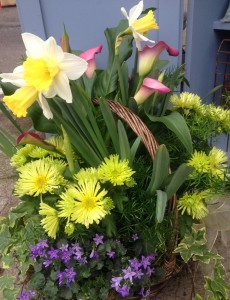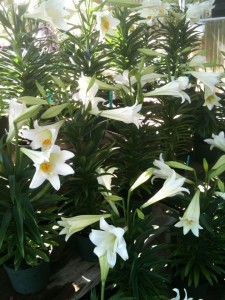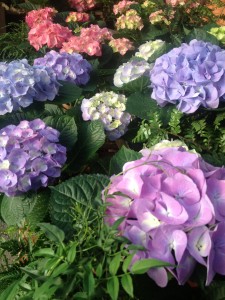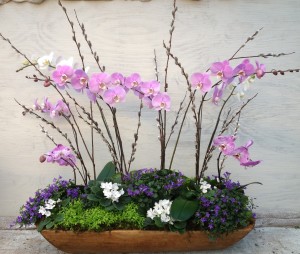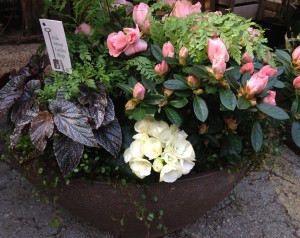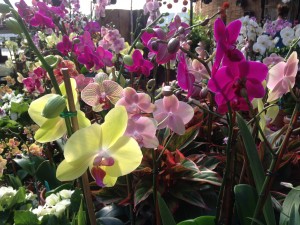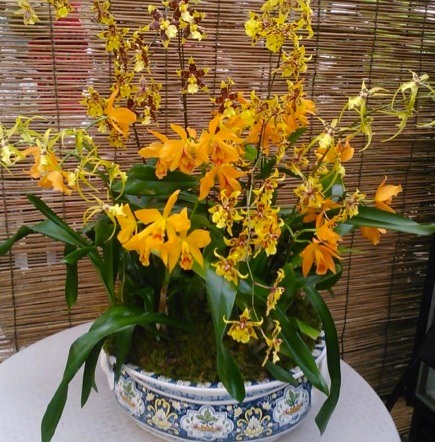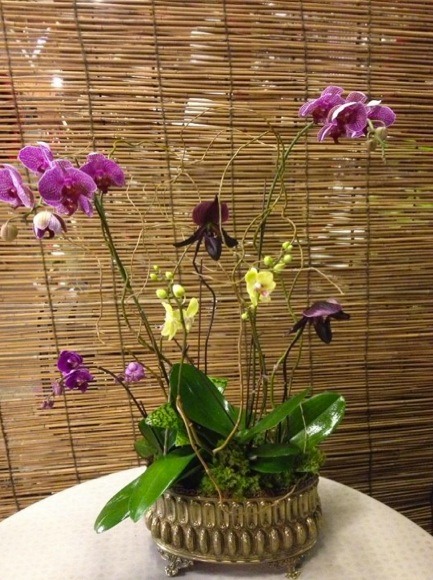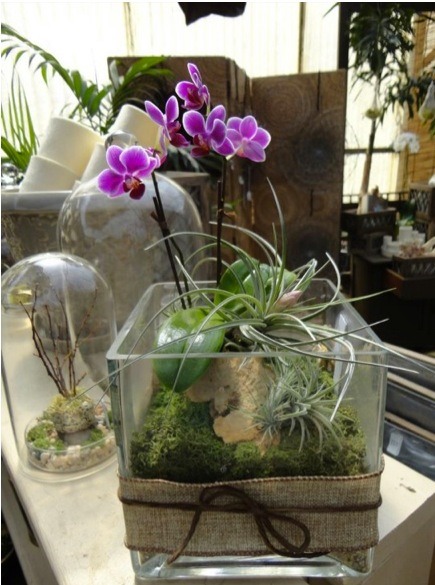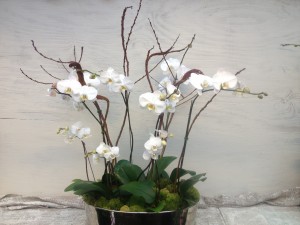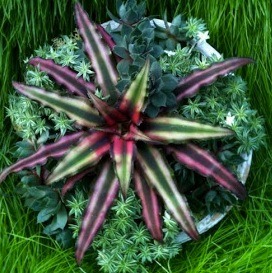Wondering what to do about your winter-weary container plantings? It’s still too early to put in the real heat lovers, but there is hope.
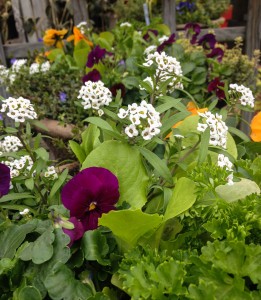
Sweet allysum, lettuce and violas
If your pots look just plain awful, it may be time to, at the very least, empty them out and add fresh potting soil so you’re either ready to freshen them now or get a jump on planting them in another month or so. (You’ll be so happy you did this when you don’t have to do it later!)
Herbs add so much to container plantings. Whether it be some thyme to trail over the edge or a bit of parsley to add some fluff, they will add texture, color, and scent…not to mention it’s nice to snip a bit here and there for cooking! Take a look at this herb post from last year for more information. While not everything in that post has arrived yet, it will soon; so keep your eyes open!
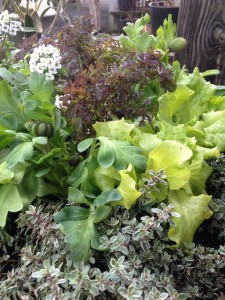
Silver thyme and lettuce brighten this planting…
Other great additions this time of year are lettuce and arugula…just in time for spring salads! Plant some now and you’ll be picking until the heat sets in and they “bolt”, or send up blooms. This will mean they’re finished for the season and need to be replaced with something that will withstand the heat of summer. Another really pretty veggie addition is red-veined sorrel…and it’s very cold hardy as well.
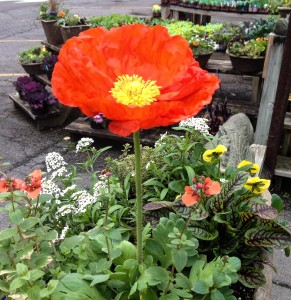
Poppy and cool season annuals, diascia, sweet allysum and pansies
This is also the time of year for what is termed “cool season annuals“. These are the flowers that shine when the nights are brisk and the days aren’t too too hot. Think sweet allysum, lobelia, heliotrope, diascia, and nemesia for starters (Though breeders have now improved the sweet allysum to withstand even our brutal summers.),
We even have the first of the geraniums in stock now; they love this late winter, early spring weather. If your pansies survived this winter, they should begin to really blooom for the next month, as well, and snapdragons will even later.

Red veined sorrel adding some color…also shown Perennial Veronica ‘Georgia Blue’, golden acorus and lemon variegated thyme…
When the heat takes it’s toll on these cool season beauties, it will be time to plant your summer combinations. We’re so lucky to be able to have more than one growing season!
A caution when using these cool season flowers, however. Be a weather watcher and protect these from any freezing temperatures. If you do this, you’ll have the prettiest planters of anyone on your block!
Remember, you can always bring your manageably sized pots in for us to plant! We also carry a good selection of the biodegradable pulp pots that look great on their own or can be dropped into another container. Like to do it yourself? Browse the nursery and collect what you want for your planters, or ask us for help choosing just the right plants.

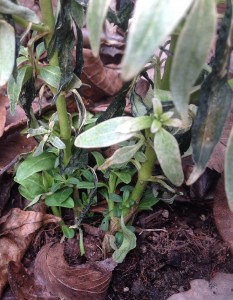

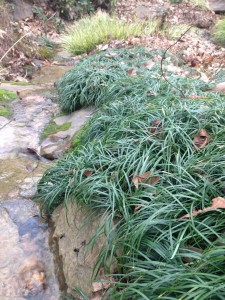
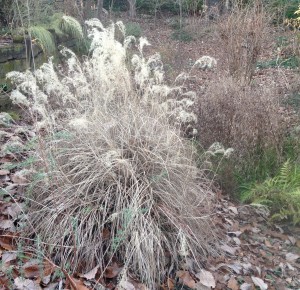
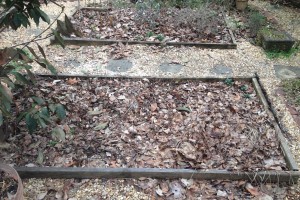
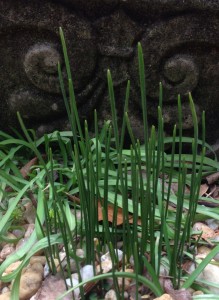

 Now that January is behind us, we can look forward to spring, knowing it is right around the corner. Until then, we’ve been satisfying our planting urges using late winter offerings from growers. We are determined to come up with something interesting on long winter days in the greenhouse!
Now that January is behind us, we can look forward to spring, knowing it is right around the corner. Until then, we’ve been satisfying our planting urges using late winter offerings from growers. We are determined to come up with something interesting on long winter days in the greenhouse!

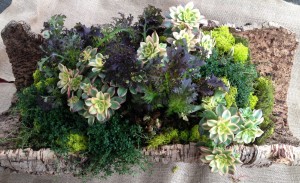 Many of the succulent aeoniums fare better here during the winter months. They seem to dislike our excessive summer humidity (Don’t we all?), and the Aeonium ‘Kiwi’ seemed just right to work into some sort of arrangement. I loved how they looked paired with this frilly dark purple leaf ornamental mustard. If I could just work it into a container that could be moved in and out easily if temperatures dropped below freezing…
Many of the succulent aeoniums fare better here during the winter months. They seem to dislike our excessive summer humidity (Don’t we all?), and the Aeonium ‘Kiwi’ seemed just right to work into some sort of arrangement. I loved how they looked paired with this frilly dark purple leaf ornamental mustard. If I could just work it into a container that could be moved in and out easily if temperatures dropped below freezing…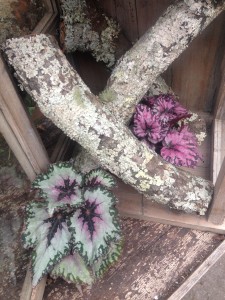


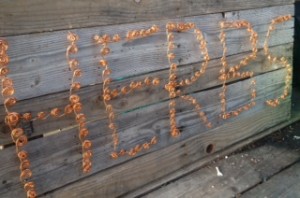
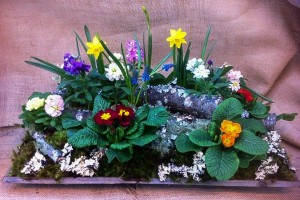
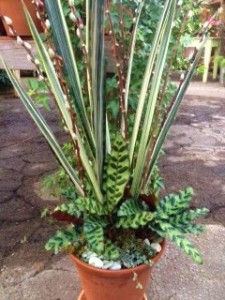
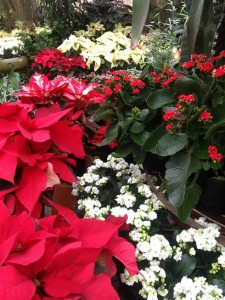 The greenhouse is so beautiful all year round, but it’s especially so in the height of the holiday season. In fact, sometimes there are so many flowers and new plants coming in almost daily that they are literally everywhere – on tables, on the floor around tables, and anywhere we can find a spare space. Never let it be said we don’t have a little something for everyone!
The greenhouse is so beautiful all year round, but it’s especially so in the height of the holiday season. In fact, sometimes there are so many flowers and new plants coming in almost daily that they are literally everywhere – on tables, on the floor around tables, and anywhere we can find a spare space. Never let it be said we don’t have a little something for everyone!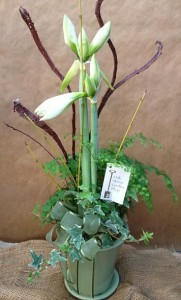
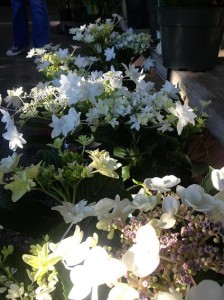
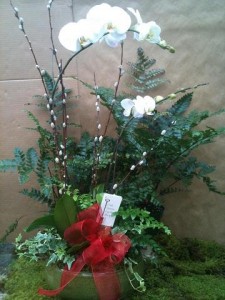
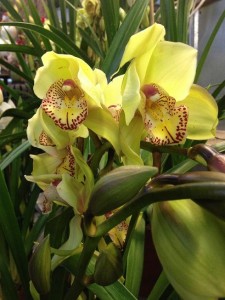

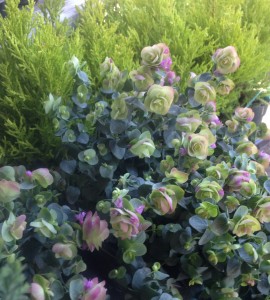
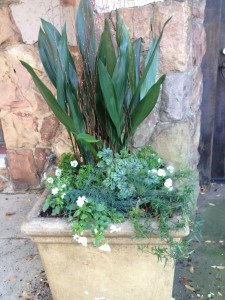
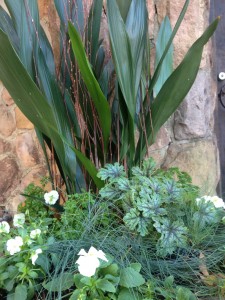 The emphasis is on foliage, though, and I’ve included curly parsley for it’s fresh green color, a small blue fescue grass, and a shade loving heuchera for this planting. Holdovers from the summer are aspidistra, which I thin out each season, and a tiny leaf green ivy. After planting, I added birch branches to add more height and winter interest. (Branches are an easy way to get color in planters during the holiday – red twig dogwood branches would also be pretty.) While it looks a bit top heavy with the tall aspidistra at first, the parsley and heuchera will add fullness to the composition as it grows in. I’m also trying the Cool Wave white trailing pansies here this year, hoping they get enough sun to bloom well.
The emphasis is on foliage, though, and I’ve included curly parsley for it’s fresh green color, a small blue fescue grass, and a shade loving heuchera for this planting. Holdovers from the summer are aspidistra, which I thin out each season, and a tiny leaf green ivy. After planting, I added birch branches to add more height and winter interest. (Branches are an easy way to get color in planters during the holiday – red twig dogwood branches would also be pretty.) While it looks a bit top heavy with the tall aspidistra at first, the parsley and heuchera will add fullness to the composition as it grows in. I’m also trying the Cool Wave white trailing pansies here this year, hoping they get enough sun to bloom well.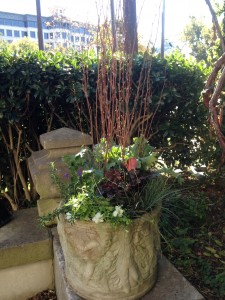
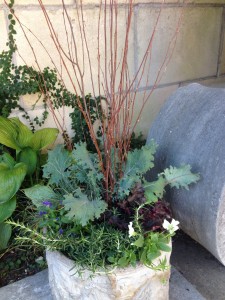 This fall Pardis asked if I would also take a look at the planters at Bottega, their other wonderful restaurant.
This fall Pardis asked if I would also take a look at the planters at Bottega, their other wonderful restaurant.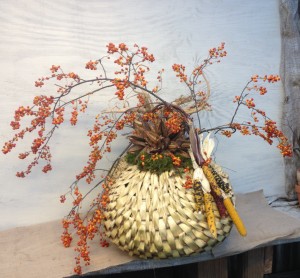 Autumn inspires us! The past month we’ve been designing with thoughts of fall…a copper container, a beautiful basket, a heavy stone trough, and even something as simple as a wooden box made wonderful starting pieces for a few of them.
Autumn inspires us! The past month we’ve been designing with thoughts of fall…a copper container, a beautiful basket, a heavy stone trough, and even something as simple as a wooden box made wonderful starting pieces for a few of them.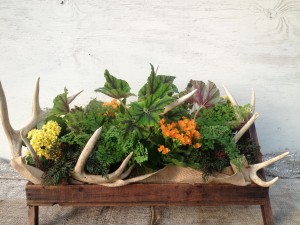 This wooden box arrangement was done for a garden club – the customer brought in the antlers! This one was a fun change of pace. Those antlers didn’t want to stay put, and the box was a tad rickety…it reminds us that each day may bring different and interesting challenges!
This wooden box arrangement was done for a garden club – the customer brought in the antlers! This one was a fun change of pace. Those antlers didn’t want to stay put, and the box was a tad rickety…it reminds us that each day may bring different and interesting challenges!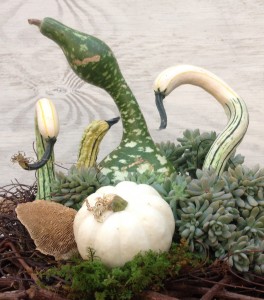


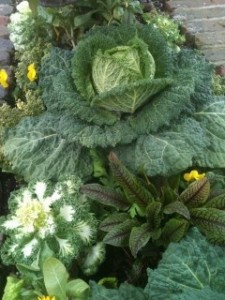
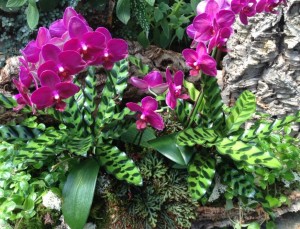 This summer’s wet, cool weather might have kept many of you out of your gardens, but we’ve managed to stay busy in the greenhouse putting together arrangements filled with orchids, succulents, houseplants, and so much more…here’s a peek at some of them. We regularly have folks who stop in just to see what we’ve been working on! All of these arrangements are composed of live plants, no cut flowers here.
This summer’s wet, cool weather might have kept many of you out of your gardens, but we’ve managed to stay busy in the greenhouse putting together arrangements filled with orchids, succulents, houseplants, and so much more…here’s a peek at some of them. We regularly have folks who stop in just to see what we’ve been working on! All of these arrangements are composed of live plants, no cut flowers here.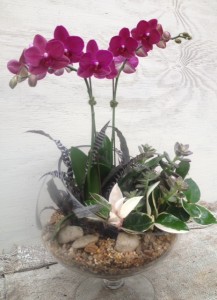
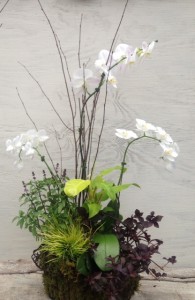
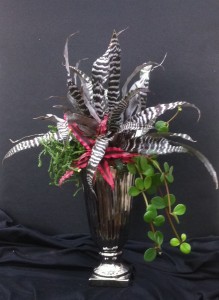 Finally, the silver container was given in memory of someone…the longlasting and low maintenance houseplants of trailiing pepperomia and cryptanthus make excellent companions. It’s gratifying, also, to know that whoever is on the receiving end will be able to enjoy this longer than a fresh flower arrangement could ever hope to last.
Finally, the silver container was given in memory of someone…the longlasting and low maintenance houseplants of trailiing pepperomia and cryptanthus make excellent companions. It’s gratifying, also, to know that whoever is on the receiving end will be able to enjoy this longer than a fresh flower arrangement could ever hope to last.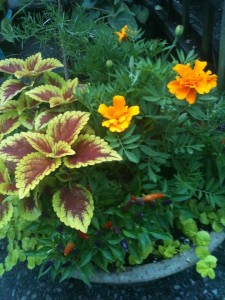 I’m not quite sure I’ve been living in the Southeast this summer…plentiful rain and decent temperatures – (Though it looks like the heat is finally returning.) this has been Alabama in August?!
I’m not quite sure I’ve been living in the Southeast this summer…plentiful rain and decent temperatures – (Though it looks like the heat is finally returning.) this has been Alabama in August?!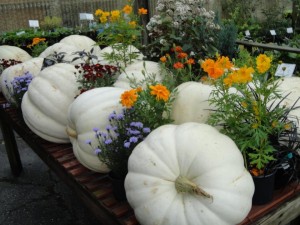
 But, if your garden and beds are struggling…think about where you’d like to see marigolds, ornamental peppers, late season salvias, and, further down the road, lettuce, asters and cool season herbs – we’ll have transplants of parsley, thyme (Look for the lemon variegated thyme which looks beautiful with green or red lettuce and marigolds.) dill and cilantro too.
But, if your garden and beds are struggling…think about where you’d like to see marigolds, ornamental peppers, late season salvias, and, further down the road, lettuce, asters and cool season herbs – we’ll have transplants of parsley, thyme (Look for the lemon variegated thyme which looks beautiful with green or red lettuce and marigolds.) dill and cilantro too.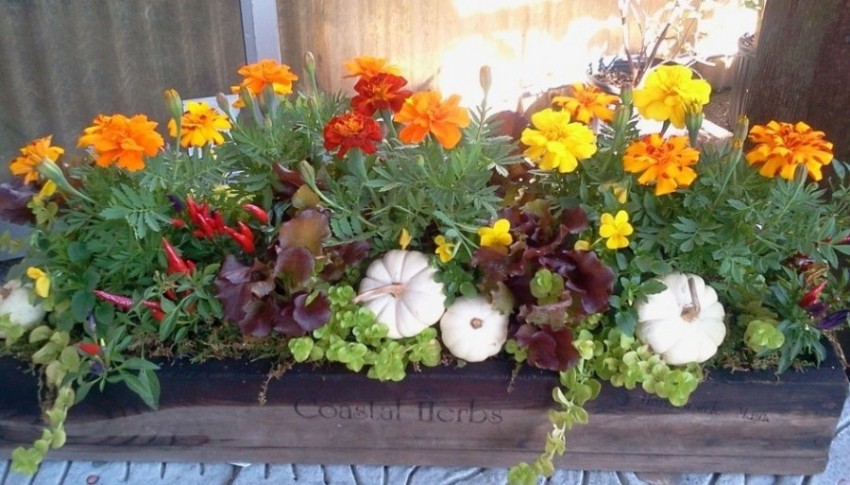
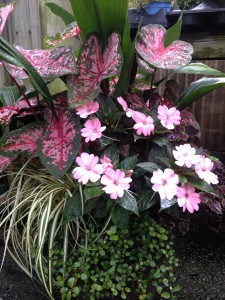
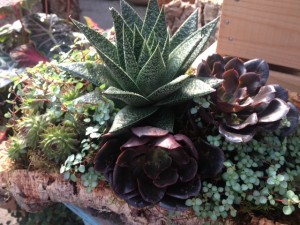
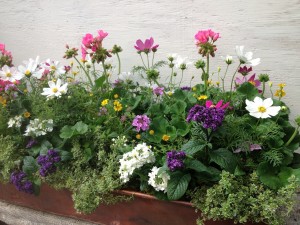
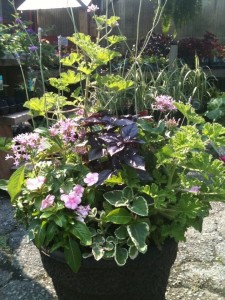
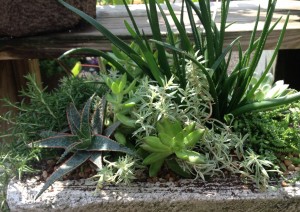
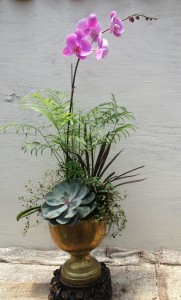
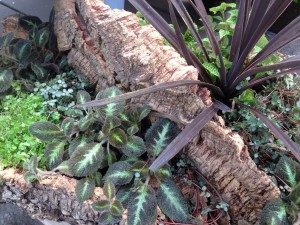
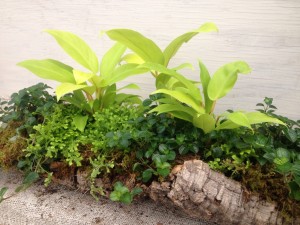
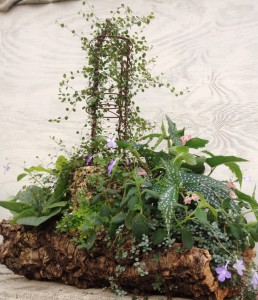
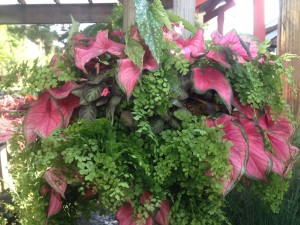
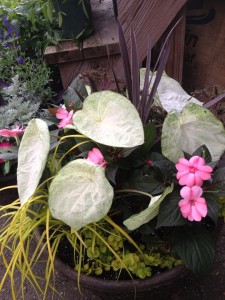 The last planting is shown to serve as an example of how you can definitely have color in the shade using foliage in addition to flowers…the ‘Garden White’ caladium in contrast with the golden carex and sunpatien really catches the eye! The planter at the top of this post is also one for shade, and, once again, the foliage is the star.
The last planting is shown to serve as an example of how you can definitely have color in the shade using foliage in addition to flowers…the ‘Garden White’ caladium in contrast with the golden carex and sunpatien really catches the eye! The planter at the top of this post is also one for shade, and, once again, the foliage is the star.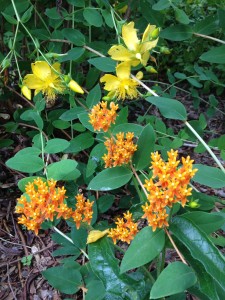 Butterfly weed, Asclepias tuberosa, is the pretty orange flower, shown in the picture on the right in my very hot and sunny front border. It’s right at home with other butterfly attractors including salvias, trailing white lantana, purple and red gomphrena, zinnias, mexican heather, other
Butterfly weed, Asclepias tuberosa, is the pretty orange flower, shown in the picture on the right in my very hot and sunny front border. It’s right at home with other butterfly attractors including salvias, trailing white lantana, purple and red gomphrena, zinnias, mexican heather, other 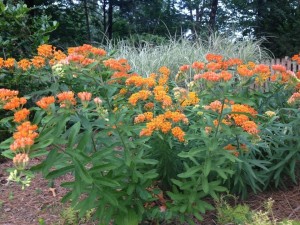
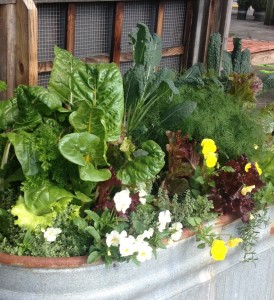


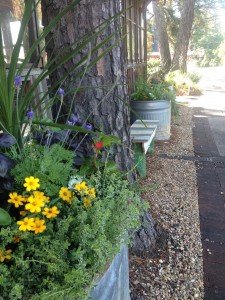
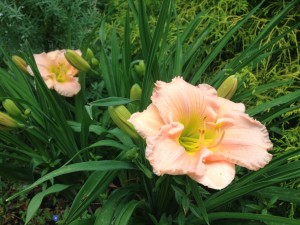 This ‘Siloam Double Classic’ daylily’s first bloom in my garden marks the beginning of summer for me. Blooming right around Memorial Day, it is also a reliable rebloomer and the last to bloom at the end of summer – August 22nd last year, to be exact!
This ‘Siloam Double Classic’ daylily’s first bloom in my garden marks the beginning of summer for me. Blooming right around Memorial Day, it is also a reliable rebloomer and the last to bloom at the end of summer – August 22nd last year, to be exact!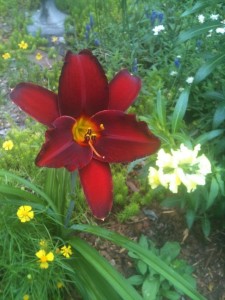
 Once the bloom period ends, cut the old bloomscapes completely to the ground, tidying the plant. If the leaves begin to look tattered at all, don’t hesitate to take the entire plant and cut all the foliage back by half. Your daylilies will reward you with fresh foliage the rest of the season, and, if they’re rebloomers, you’ll have another round of flowers!
Once the bloom period ends, cut the old bloomscapes completely to the ground, tidying the plant. If the leaves begin to look tattered at all, don’t hesitate to take the entire plant and cut all the foliage back by half. Your daylilies will reward you with fresh foliage the rest of the season, and, if they’re rebloomers, you’ll have another round of flowers!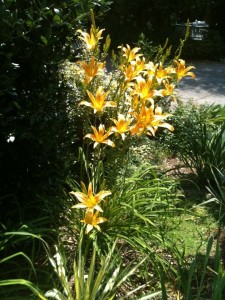
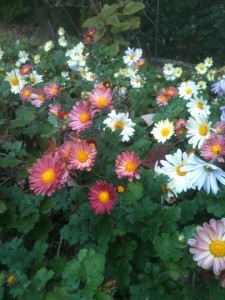


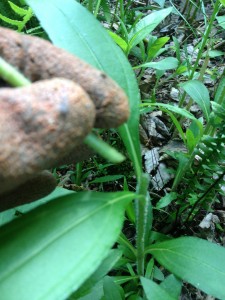
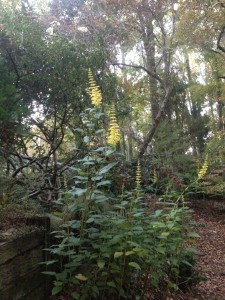

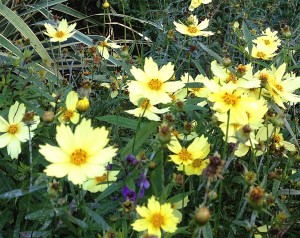
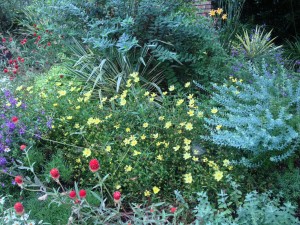

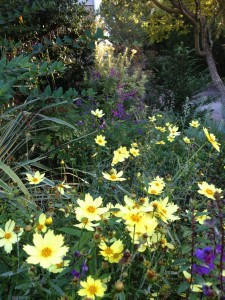
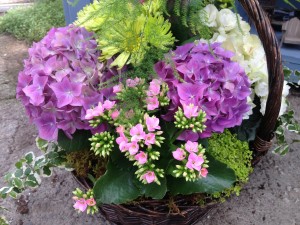
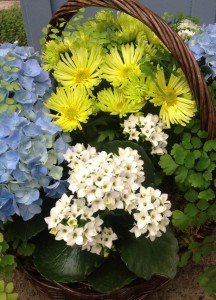
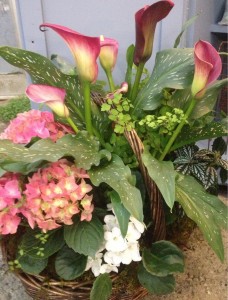
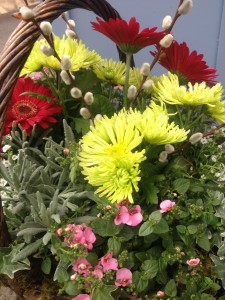
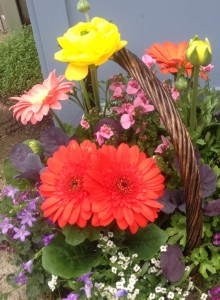 And there are such pretty things to play with! This time of year, with spring in the air but not quite yet here – this is the time of hydrangeas, calla lilies and sweet alyssum – the soft colors of Easter mingling and overlapping with the brightness of other, more exuberant blooms of gerbera daisies, ranunculus and the first of the geraniums. So much to work with! So we begin to gather flowers and foliage and perhaps a few herbs to add their scent, color and texture to the mix.
And there are such pretty things to play with! This time of year, with spring in the air but not quite yet here – this is the time of hydrangeas, calla lilies and sweet alyssum – the soft colors of Easter mingling and overlapping with the brightness of other, more exuberant blooms of gerbera daisies, ranunculus and the first of the geraniums. So much to work with! So we begin to gather flowers and foliage and perhaps a few herbs to add their scent, color and texture to the mix.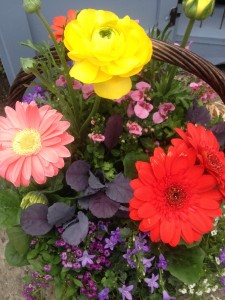 This post isn’t going to be about design rules, because quite frankly, we sometimes break them. (Maybe we’re just rebels at heart!) No, this is about what feels and looks right to you. And, perhaps it’s more about not being afraid of making a “mistake” – with arrangements, container plantings or your own garden.
This post isn’t going to be about design rules, because quite frankly, we sometimes break them. (Maybe we’re just rebels at heart!) No, this is about what feels and looks right to you. And, perhaps it’s more about not being afraid of making a “mistake” – with arrangements, container plantings or your own garden.